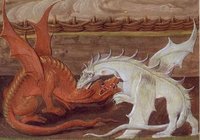0





| Thumbs Up |
| Received: 6 Given: 1 |

















| Thumbs Up |
| Received: 14,063 Given: 6,639 |

Try to find one study that shows the Anglo-Saxons were genetically closer to the Irish than to the English (even leaving aside the fact that Anglo-Saxons and English were synonymous until the 10th/11th centuries).
https://www.nature.com/articles/s41586-022-05247-2
https://www.nature.com/articles/ncomms10326
Ancient sample ancestry within Britain
To place our ancient genomes within a detailed British context, we next plotted these in a background PCA using 3,075 published genotypes from British3, Irish23 and southern Netherlands samples24. The modern samples were analysed using SNP genotypes at ∼250,000 loci and projected into a single plot using smartpca (Fig. 3a). As in Burton et al.3 the first component of the variation was informative for the structure within Britain. Given the close ancestral relationships between these populations and their well-known history of migrational exchange, a substantial overlap between regional groups was both expected and observed. However, by considering median values, one can see a clear progression from Irish samples at one pole through Scottish, Welsh, English to the Dutch cohort at the other extreme. In this plot the York Romans cluster centrally close to the modern Welsh median value, along with the Iron-Age genome. The local Anglo-Saxon is placed differently, closest to modern East Anglians between the English and Dutch medians.
http://www.tara.tcd.ie/handle/2262/82960
Do you also wonder if Anglo-Saxons looked more like the Irish than North Germans, since G25 says they're genetically closer?The Establishment of Irish Haplotypic Diversity
The second component of variation (Fig. 4.6B-C) is unique in that it explains a large amount of variation present in both ancient and modern individuals. This corresponds to the primary split seen in fineSTRUCTURE analysis by Byrne et al. (submitted), which segregates Ireland and Britain into two distinct genetic islands, capturing what is defined as an Anglo-Celtic cline. Western Ireland and southeastern Britain form the two extremes of this component, with the Scottish population bridging the gap between the two clusters. Strikingly, ancient samples also separate out along this axis, with Irish individuals from both the Early Bronze Age and Iron Age periods falling further towards modern Irish variation than their British and continental counterparts (Fig. 4.6B-C). Irish Iron Age samples extend the entire range of Irish variation on PC2, suggesting substantial continuity with the modern population. Irish Early Bronze Age samples show a more constricted distribution closer to the center of the plot, but still exhibit a systemic shift towards Irish Iron Age and modern populations, particularly those from individualised burials. The most parsimonious explanation for such observations is direct continuity between the Chalcolithic/Early Bronze Age and modern period in Ireland, with much of the haplotypic variation explained by PC2 forming in the intervening millennia, in a similar manner as suggested for Wales in PC3. While migration may be partially responsible for this structure, it is worth noting that the Irish Iron Age and modern population typically extends away, rather than towards, any potential external sources of variation in the dataset, including a contemporary Iron Age population from Britain, the most likely source of migration into Ireland between the Bronze Age and Early Christian periods. However, several exceptional Irish Iron Age samples exist, returned to in later sections.
The homogenisation of British population structure through admixture
In contrast to the gentle gradient of ancient Irish variation, British and continental individuals show a more punctuated distribution along PC2 (Fig. 4.6B-C), forming two clear clusters at both ends of modern British variation. Anglo-Saxons fall with southeastern English variation in this and all other PCs considered, alongside a Nordic Iron Age sample, reflecting the large genetic contribution of Germanic migrations to this part of the island (Leslie et al. 2015; Schiffels et al. 2016). Iron Age Britons comprise another tight grouping at the opposite end of British variation, emphasising the admixed nature of the modern population (Leslie et al. 2015; Martiniano et al. 2016; Schiffels et al. 2016).
Distance to: England_EarlyMedieval_Saxon.SG
0.03036594 Irish
0.03570584 German_Hamburg
Last edited by Creoda; 04-26-2024 at 04:52 AM.
Spoiler!



| Thumbs Up |
| Received: 6 Given: 1 |

this is not as extensive as this does not cover the samples specifically from early anglo saxon settlers from around 500-early 700, those samples are closest to modern day danes, norweigans and dutch or icelandics, not modern day English, also g25 also says they are closest to scandanvians and dutch in comparison to the irish

















| Thumbs Up |
| Received: 14,063 Given: 6,639 |



| Thumbs Up |
| Received: 6 Given: 1 |















| Thumbs Up |
| Received: 25,594 Given: 29,041 |

















| Thumbs Up |
| Received: 14,063 Given: 6,639 |

This thread was about Irish vs English closeness to Anglo-Saxons, that's what I responded to. No idea why you're bringing Scandinavians into it.
And btw, Saxon and Kentish English were already mixed and likely closer to modern English than Scandinavians by the 600s-700s.

Spoiler!



| Thumbs Up |
| Received: 6 Given: 1 |



| Thumbs Up |
| Received: 6 Given: 1 |

In g25 it's possible to perform such a deciphering, but it's more complex, however, it's the general consensus that they were closest to Danes and Scandinavians and dutch, not just based on g25 calculation
"The researchers found that the new arrivals into England following the collapse of the Romans shared the greatest similarity with the genetic makeup of remains from northern Germany and the Netherlands, as well as Denmark and southern Sweden."















| Thumbs Up |
| Received: 25,594 Given: 29,041 |
There are currently 1 users browsing this thread. (0 members and 1 guests)
 England
England
 England
England
 England
England
Bookmarks